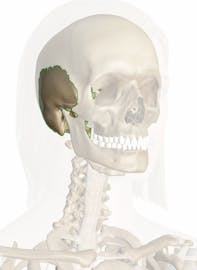Temporal Bone

The temporal bone is one of two bones that form parts of the sides and base of the cranium. A temporal bone on each side of the skull joins the parietal bone along the squamosal suture. The superior temporal line is the topmost curved line on the parietal bone and lies above the inferior temporal line. This is where the temporal fascia attaches. The inferior temporal line also lies on the parietal bone, and is the site of attachment of the temporal muscle. Located near the lower edge is a gap, the external auditory meatus, which leads inward to parts of the ear. The temporal bones house the internal structures of the ear and have depressions, the mandibular fossae, which join the processes of the mandible. Below each external auditory meatus, there are two projections: a rounded mastoid process and a long, pointed styloid process. The mastoid process provides an attachment for certain muscles of the neck, while the styloid process serves as an anchorage for muscles associated with the tongue and pharynx. The mastoid foramen is a prominent opening in the temporal bone, which is located behind (or posterior) to the mastoid process. Generally, it provides the opening through which a vein and artery pass. A zygomatic process projects from the front of the temporal bone in the region of the external auditory meatus. It joins the zygomatic bone and helps form the prominence of the cheek.


